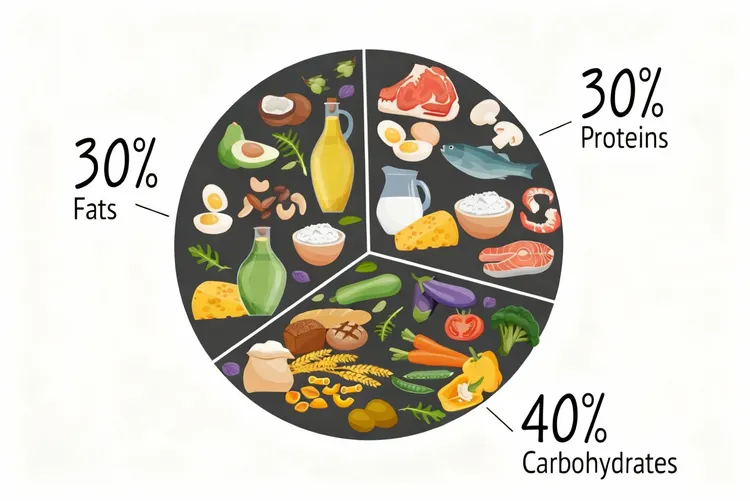How to Build a Balanced Plate: The 30-30-40 Method Explained
If you’ve ever stared at your plate wondering whether it’s actually balanced - or if you’re accidentally building a meal that’s going to leave you hungry, sluggish, or reaching for snacks an hour later - the 30-30-40 method is one of those quietly brilliant approaches that makes everything feel simpler. It’s not a strict diet rule or something you have to measure with military precision. It’s more like that gentle guideline that sits in the back of your mind, nudging you toward meals that feel satisfying, nourishing, and steadying all at once. And honestly, once you “get” it, you start noticing how wildly unbalanced most of our everyday meals tend to be, especially when life gets busy.

The whole idea rests on dividing your plate into approximate portions: 30% protein, 30% healthy fats, and 40% carbohydrates - preferably the ones that come from fruits, veggies, and whole grains rather than the sugary, refined versions that send your energy levels bouncing around like a pinball. What makes this method so appealing is that it’s not about restriction; it’s about harmony. Each part of your plate plays a role in how your body feels, digests, and functions throughout the day, and this ratio gives you a rhythm that just works.
Protein takes up the first 30%, and this is basically your anchor. It’s what helps you stay full, hold onto muscle, and keep your energy on a more even track. Too many meals lean heavily on carbs with just a little protein sprinkled in as an afterthought, and that’s usually when hunger hits you from behind later. With the 30-30-40 method, protein steps up as a main character. Whether you choose chicken, tofu, fish, eggs, legumes, Greek yogurt, or a mix of plant-based options, the goal is simply to make sure it’s clearly present and not just a background extra.
Then there’s the 30% fats, which always surprises people because we’ve all spent so many years hearing about “low-fat” everything. But healthy fats are basically the slow-burning logs on your metabolic fire. They keep meals satisfying, support hormones, help absorb fat-soluble vitamins (A, D, E, and K), and add that luscious, flavorful richness that makes a meal feel complete. Think olive oil drizzled on roasted veggies, creamy avocado on the side, a handful of nuts tossed into a salad, or salmon bringing its naturally rich omega-3s to the plate. These types of fats don’t weigh you down - they actually help balance blood sugar and keep cravings in check.
Finally, the 40% carbohydrates, which honestly shouldn’t scare anyone. Carbs are not the enemy - they’re your body’s favorite source of energy. The trick is choosing ones that bring fiber, minerals, and slow-release energy to the table. A plate built with the 30-30-40 ratio would lean toward things like quinoa, brown rice, potatoes, oats, whole-grain pasta, beans, lentils, or vibrant fruits and vegetables. When carbs come from whole foods instead of refined sources, they keep you energized instead of spiking and crashing. And with protein and fats sharing the plate, that energy release becomes even steadier.
What people love most about this method is how flexible it is. You don’t have to count grams or whip out a calculator at dinner. You can eyeball your plate in a really intuitive way: a generous serving of carbs you enjoy, a solid portion of protein, and a noticeable, not-scared-of-it amount of healthy fats. Suddenly, meals that used to feel mysterious start making sense. For example, if you’ve ever eaten a huge bowl of plain pasta and wondered why you were starving later, you’ll understand it immediately through this lens. But if you turn that pasta into a balanced plate - toss in grilled chicken or beans, add olive oil, maybe some parmesan for extra fat and protein, load it with veggies - you’re suddenly looking at a dish that keeps you full for hours and tastes even better.
The beauty of the 30-30-40 method is how effortlessly you can adapt it to your favorite meals. Breakfast could be oats (your carbs), topped with Greek yogurt (protein) and a sprinkle of nuts or nut butter (fat). Lunch might be a big vibrant salad with quinoa, grilled salmon, and avocado. Dinner could be tacos with beans or shrimp, salsa, roasted veggies, and a drizzle of lime crema. Even snacks shift into balance - think apple slices with almond butter or hummus with whole-grain crackers. You’re not removing joy from your meals; you’re adding structure that actually makes them more enjoyable and more satisfying.
There’s also something empowering about understanding why a balanced plate matters. When your meals align with this ratio, your blood sugar behaves more gracefully, your mood and energy feel more stable, and those late-night cravings lose their grip. It’s not magic - it’s biology responding to nutrients in the proportions it likes best. Over time, this way of eating supports everything from digestion to metabolism to hormonal health, and it does so without feeling like a restrictive plan you have to “stick” to. It just becomes part of how you naturally build meals.
In a world full of complex diet advice and trendy eating patterns that promise the world and deliver burnout, the 30-30-40 method is almost refreshingly simple. It respects your hunger, your lifestyle, your cravings, and your common sense. And honestly, that’s part of its charm. Once you start building plates this way, you may find your meals feel more balanced, your energy lasts longer, and your connection to food becomes easier and more intuitive. It’s a gentle reset, not a revolution - and sometimes, that’s exactly what your body has been asking for.









